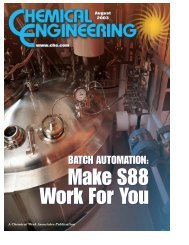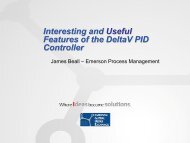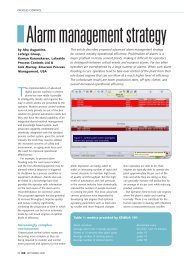safety instrumented systems: can they be integrated but separate
safety instrumented systems: can they be integrated but separate
safety instrumented systems: can they be integrated but separate
You also want an ePaper? Increase the reach of your titles
YUMPU automatically turns print PDFs into web optimized ePapers that Google loves.
This evolutionary system is really only <strong>integrated</strong> at the HMI level. Theengineering and operations functionality is isolated from the actual logic solverusing a <strong>safety</strong> write protection layer of software. This layer protects the logicsolver from receiving unsolicited data from elements in the BPCS system.Although the engineering/configuration environment appears to <strong>be</strong> identical tothe BPCS and utilizes a common format there are signifi<strong>can</strong>t differences in theactual operation. The <strong>safety</strong> system configuration tools require a completelydifferent level of security for access and use. When an individual logs on, he/shemust have Safety security clearance to <strong>be</strong> allowed into the <strong>safety</strong> configurationenvironment. Once in the <strong>safety</strong> configuration mode a completely different andunique set of TUV approved function blocks are available that <strong>can</strong> <strong>be</strong> configuredand downloaded to a <strong>safety</strong> logic solver. Safety blocks <strong>can</strong>not <strong>be</strong> downloaded toa BPCS controller and BPCS function blocks and code <strong>can</strong>not <strong>be</strong> downloaded toa SIS module.The HMI layer combines data in the event summaries, historical data base, etc.and allows the BPCS access to all the information from the SIS <strong>but</strong> does notallow the BPCS to write to the SIS. This feature eliminates the need for the datamapping and buses previously needed to integrate these elements. Each tag isdefined one time in the system as either an SIS or BPCS tag. It is then availablefor trending, display on graphics, historization, etc.The BPCS and SIS <strong>systems</strong> share a common Alarm Summary Screen. SISAlarms are shown in a different category from process alarms. SIS events arealso <strong>integrated</strong> into the BPCS Event Chronicle. This allows for SIS events to <strong>be</strong>sorted <strong>separate</strong>ly from the BPCS events or sorted by time to see process andSIS reactions to a certain event. The SIS Network is <strong>integrated</strong> into theDiagnostics Explorer as well for easy viewing of SIS network and hardwarediagnostics.AMS ADVANTAGESThe architecture discussed above is an <strong>integrated</strong> SIS system that takes intoaccount the HART diagnostics from the end devices in the SIF. This system wasdesigned to comply with IEC 61508 and to make it easier for end user’s tocomply with IEC 61511.Using intelligent field devices communicating using the HART protocol providesimproved <strong>safety</strong> and signifi<strong>can</strong>t cost reductions in operations and maintenance.These savings result from extensive diagnostics allowing longer test intervals.HART data is used within the SIS to determine the data integrity of point <strong>be</strong>forethe SIS reacts to it. This improves plant availability by lowering the num<strong>be</strong>r ofspurious trips caused by malfunctioning devices.By eliminating the need for muxes there are fewer third party componentsneeded within your BPCS and SIS <strong>systems</strong>. It also allows for a seamless






